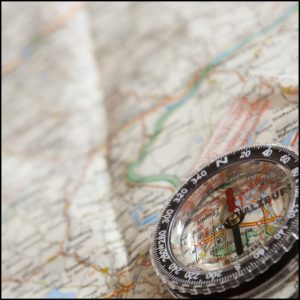 In creating a Secondary World, a Sub-Creator sets out on a journey into a new world. It is a journey into new places, where the shapes of the land may be quite different from the ones we see about ourselves every day. The landscape of a Secondary World may have elements resembling ones found in reality: a broad moor under grey skies where the wind is cruel and cold; a sun-washed mountainside where tall, haughty pines stand at the foot of a cliff; a feathery ribbon of waterfall shimmering in the midst of lush greenery. Yet the Author’s journey will lead through territory of one sort or another, through previously uncharted realms.
In creating a Secondary World, a Sub-Creator sets out on a journey into a new world. It is a journey into new places, where the shapes of the land may be quite different from the ones we see about ourselves every day. The landscape of a Secondary World may have elements resembling ones found in reality: a broad moor under grey skies where the wind is cruel and cold; a sun-washed mountainside where tall, haughty pines stand at the foot of a cliff; a feathery ribbon of waterfall shimmering in the midst of lush greenery. Yet the Author’s journey will lead through territory of one sort or another, through previously uncharted realms.
In the process of telling his tale, the Sub-Creator will be verbally charting these unknown lands. However, as a practical matter, the making of a map can be of great help to the Sub-Creator. In his introduction to An Atlas of Fantasy (Ballantine Books, 1979), Lester Del Rey observes that
… the author who seeks to travel through his world of fantasy is as much in need of a guide as in the one who charts a story of any other exploration. Without a map, his sense of time and distance soon becomes confused. (AF, p.v.)
It is not simply the sense of time and distance which is aided by a map of this new land, however. Del Rey continues: “A good map brings the territory into sharp focus, giving it a sense of reality otherwise lacking” (AF, p.v.).
A map can reveal to the Sub-Creator surprising things about his world. Seeing a river flowing through mountainous country, the Author may discover a reason for his hero’s tardiness: the fellow had to go far downstream before he could find a place to ford the river. However, a certain degree of rational caution is needed by the Author in drawing up a map of his world. As Lin Carter in Imaginary Worlds (Ballantine Books, 1973) points out, “Geography does not just happen – natural features are where they are due to certain causes” (IW, p. 180, emphasis Carter’s). Carter continues by pointing out
You cannot really have a lush rain-forest smack up against a parched desert of burning sand, you know; it pays to do a bit of reading into climatology so as to understand the interplay of forces that create deserts and rain-forests, jungles and grasslands, and so on. Nor can you stick mountains about your map in a helter-skelter fashion; mountains have good reasons for being where they are, and a fantasy writer should know something about them. (IW, p. 180)
Such practical considerations may seem to be a disruption of the creative process. However, landscape can have as much character as the people who inhabit it.
In this urban age, it may be a bit difficult for some writers to easily conjure up rural landscapes. Yet the effective visualization of geography can breathe life into the reader’s travels in the Secondary World. The place for the Author to begin is with settings he knows. In Past Watchful Dragons (Macmillan, 1979), Walter Hooper makes this observation about Lewis’ presentation of Narnia:
His description of Narnian countryside, weather, and food are, I expect, more effective than we first realise in contributing to the astonishing sense of reality achieved in these books. Not surprisingly, they are based on the countries Lewis knew and liked best: the British Isles and the Republic of Ireland, which are the only countries he knew well.(PWD, p. 74)
In general and in specific, places the Author has known can be transformed into places in the Secondary World. In The Letters of J.R.R. Tolkien (Houghton Mifflin, 1981), one can find examples of this process:
The hobbit’s (Bilbo’s) journey from Rivendell to the other side of the Misty Mountains, including the glissade down the slithering stones into the pine woods, is based on my adventures in 1911… (LT, p. 391)
Even the wonderful Glittering Caves of Helm’s Deep are a reflection of the real world.
… the passage was based on the caves in Cheddar Gorge and was written just after I had revisited these in 1940 but was still coloured by my memory of them much earlier before they became so commercialized. (LT, p. 407)
The shaping of the land of a Secondary World begins in a general form drawn on a map. As the Author and his characters travel across the landscape, its general features are colored by the countryside the Author knows. And specific locales are often born from places the Author has seen and touched. But the key lies in the knowing, in the mind of the Author, for it is there that the descriptive words that give life to these places live. It is the Author’s power of Sub-Creation that conjures the geography of his world.
(first published in Mythlore 40, Autumn 1984) (revised 2006)

Pingback: Adding the ScribblerWorks Logo | ScribblerWorks News